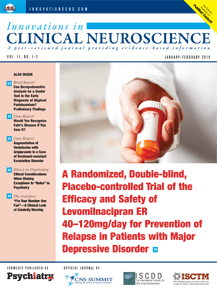Welcome to the January-February 2014 issue of Innovations in Clinical Neuroscience. We start this issue with an original research article by Shiovitz et al titled, “A Randomized, Double-blind, Placebo-controlled Trial of the Efficacy and Safety of Levomilnacipran ER 40–120mg/day for Prevention of Relapse in Patients with Major Depressive Disorder.” In a 24-week, Phase III, randomized, double-blind, controlled trial, the authors compared levomilnacipran ER (LVM-ER) with placebo for relapse prevention in patients with MDD who had responded to 12-week, open-label treatment with LVM-ER. Though the time to relapse was longer for LVM-ER versus placebo, the treatment difference was not statistically significant. This may be potentially due to lower than expected relapse rates in the placebo group.
Next, Calabro et al present a brief report titled, “Can Baropodometric Analysis be a Useful Tool in the Early Diagnosis of Atypical Parkinsonism? Preliminary Findings.” The authors retrospectively studied 20 subjects with parkinsonism using clinical and baropodometric tools to give quantitative and objective data on the postural, balance, and gait disturbances. The statistical analysis between atypical parkinsonism and Parkinson’s disease patients showed a significant difference in the frequency of long lead time parameter, foot area, foot load and speed, and, in particular, atypical parkinsonism patients presented a prevalent long lead time impairment (8/8 patients) when compared with Parkinson’s disease patients. The authors conclude that baropodometric investigation may a valuable tool for the definition of postural and motor extrapyramidal abnormalities, permitting an earlier differentiation between atypical parkinsonism and Parkinson’s disease.
Following this, Turner et al present their case report, “Augmentation of Venlafaxine with Aripiprazole in a Case of Treatment-resistant Excoriation Disorder.” The authors describe a 21-year-old woman with excoriation disorder who was resistant to currently reported treatment options. The addition of aripiprazole to the venlafaxine she was already taking resulted in resolution of her unconscious picking. The authors also provide a discussion on diagnosis and current and potential treatment options for this newly recognized DSM-5 disorder.
Next, Goyal et al ask the question “Would you recognize Fahr’s disease if you saw it?” Here the authors describe a case of an 18-year-old woman who was hospitalized for irritability and aggressive, dyscontrolled behavior that was worsening over the last four years. Brain imaging with computerized tomographic scanning that revealed bilateral brain calcifications of the basal ganglia combined with a familial history of cognitive impairment in several relatives confirmed the diagnosis of familial basal ganglia calcification, or Fahr’s disease. The authors review diagnostic and treatment options for this rare disease.
Following this, Dr. Randy Howe presents this month’s “Ethics in Psychiatry” column titled, “Ethical Considerations When Making Exceptions to ‘Rules’ in Psychiatry.” The author discusses several conflicting situations in which psychiatrists may be forced to choose between doing what they believe is best for an individual patient and following the “rules”—rules that may include evidence-based standards or guidelines in psychiatric treatment and/or policies set forth by hospitals or institutions. In addition to discussing the ethical considerations, the author provides some examples of conflicting situations and offers suggestions.
And finally, in this month’s “The Interface,” Sansone and Sansone present, “I’m Your Number One Fan”—A Clinical Look at Celebrity Worship.” The authors ask the question, “Celebrity worship—is it more than just being a casual fan?” Here, the authors review several scales that have been developed to assess celebrity adulation and also examine some studies associated with these scales. Findings reveal that individuals with high scores on celebrity-worship scales tend to display a number of psychosocial characteristics, including concerns about body image, sensation-seeking behaviors, cognitive rigidity, identity diffusion, and poor interpersonal boundaries. Likewise, celebrity worshippers may exhibit narcissistic features, dissociation, addictive tendencies, stalking behavior, and compulsive buying. Recognizing the presence of celebrity worship may help alert primary care physicians of more severe mental disorders in certain patient populations.
We hope you enjoy this issue of the journal. As always, we welcome your feedback and submissions.
Sincerely,
Amir Kalali, MD
Editor, Innovations in Clinical Neuroscience






